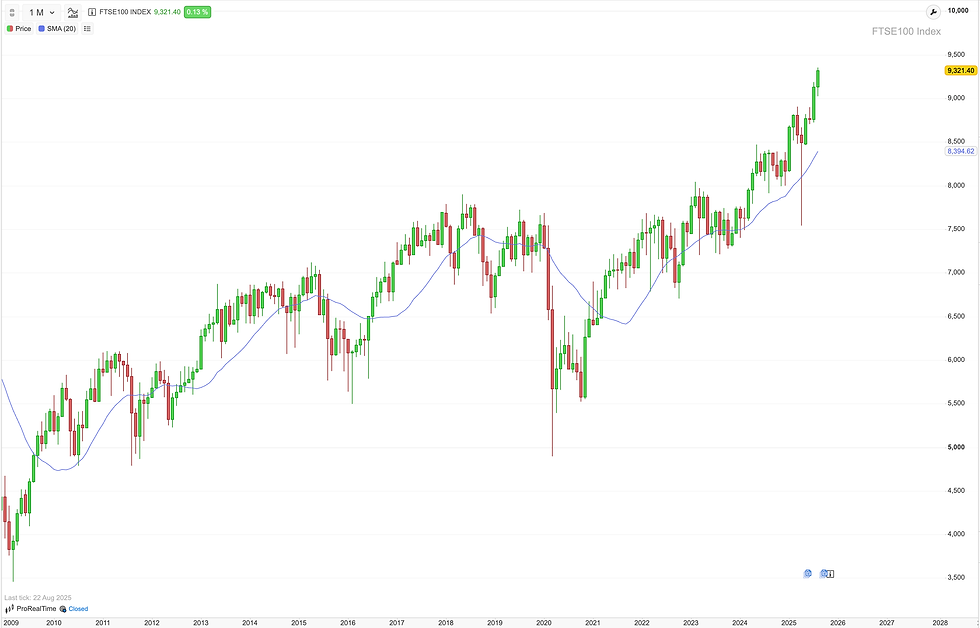Policy Crossroads: UK Growth, US Cuts, and What It Means for Investors
- Blake Reddy
- Aug 24
- 3 min read

Each week, we try to step back from the noise and look at what really matters for savers and investors. This week brought two important developments on either side of the Atlantic. In the UK, the economy has surprised with stronger growth, improved confidence, and a buoyant FTSE, but Chancellor Reeves still faces the challenge of plugging a sizeable fiscal hole in her autumn budget. Meanwhile in the US, Jerome Powell used his Jackson Hole speech to hint that the Federal Reserve may soon begin cutting interest rates, sparking a rally across global markets.
The common thread? Policy is at a crossroads. Britain must balance optimism with tax rises, and the US must weigh inflation risks against a softening labour market. For investors, these moments matter as they shape the outlook for cash, bonds, and equities in the months ahead.
The UK: Green Shoots Amid Fiscal Clouds
A year ago, Britain’s economic story was one of gloom. Chancellor Rachel Reeves warned of “pain,” and Prime Minister Keir Starmer spoke of a dire inheritance from the previous government. Yet the most recent data paints a different picture.
GDP rose by 0.3% in the second quarter - three times stronger than forecast - and 1.2% over the year. The ONS has revised last year’s nominal GDP 1.5% higher. Consumer confidence has bounced back to levels last seen before Christmas. Job losses tied to Reeves’ payroll tax hike have proven far fewer than expected, and even the much-discussed mortgage refinancing wave looks less painful, with 2.5 million households expected to move onto cheaper deals in the years ahead. Corporate balance sheets, too, look far sturdier than in 2008.
Still, challenges loom. Reeves must raise between £20 and £50 billion in the autumn budget to satisfy her fiscal rules - almost certainly through higher taxes or threshold freezes. Productivity remains stubbornly weak. Much of the growth we’ve seen so far has been flattered by temporary boosts: government spending and exporters racing to get ahead of new tariffs. Meanwhile, analysts warn the second half of 2025 could be softer.
Even so, markets have taken heart. The FTSE 100 gained around 2% this week, outpacing Wall Street despite a strong Friday rally in the US.
FTSE 100: 2009 - Present:

The US: Powell Opens the Door
Across the Atlantic, Jerome Powell’s Jackson Hole speech gave markets the signal they had been waiting for. Having kept rates steady since December, the Fed Chair acknowledged rising risks in the labour market and opened the door to a September cut.
Markets surged on the news. Treasury yields fell, the dollar slipped, and equities staged their sharpest cross-asset rally since April: the S&P 500 rose 1.5% on Friday, while the Nasdaq gained nearly 2%. Gold and even Bitcoin climbed higher on hopes of easier policy.
Yet behind the excitement lies division. Some Fed policymakers want multiple cuts, others argue for just one, and a vocal minority still believe inflation risks are too high to justify easing. Powell was careful not to commit beyond September, stressing that the Fed will remain “data dependent.” His caution reflects a delicate balance: tariffs are pushing prices higher, but waiting too long to act risks tipping the labour market into a downturn.
Where Is Your Pension Invested?

What This Means for Investors
Both the UK and the US are at inflection points. Britain’s economy is stronger than expected, but the fiscal outlook is tightening. In the US, Powell has signalled easier policy, but divisions within the Fed highlight just how uncertain the path really is.
For investors, the message is clear: cash is once again losing ground to inflation, equity markets are sensitive to every policy signal, and bonds are beginning to look attractive as expectations of rate cuts grow. Above all, diversification across regions and asset classes remains essential.
At K2 Private Wealth, our role is to look beyond this week’s headlines and ensure your portfolio is positioned for the medium-term shifts that matter most.
If you’d like, we’d be happy to run a personalised portfolio analysis showing how your investments are positioned across regions and sectors, and how they might perform under different economic and market scenarios. It’s a useful way to ensure your strategy remains well-diversified and aligned with your long-term goals.




.png)
Comments